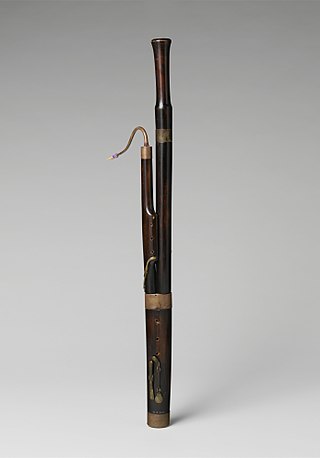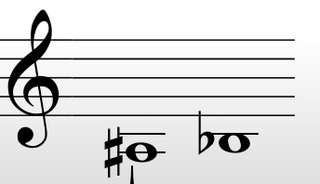
The bassoon is a musical instrument in the woodwind family, which plays in the tenor and bass ranges. It is composed of six pieces, and is usually made of wood. It is known for its distinctive tone color, wide range, versatility, and virtuosity. It is a non-transposing instrument and typically its music is written in the bass and tenor clefs, and sometimes in the treble. There are two forms of modern bassoon: the Buffet and Heckel systems. It is typically played while sitting using a seat strap, but can be played while standing if the player has a harness to hold the instrument. Sound is produced by rolling both lips over the reed and blowing direct air pressure to cause the reed to vibrate. Its fingering system can be quite complex when compared to those of other instruments. Appearing in its modern form in the 19th century, the bassoon figures prominently in orchestral, concert band, and chamber music literature, and is occasionally heard in pop, rock, and jazz settings as well. One who plays a bassoon is called a bassoonist.

The French horn is a brass instrument made of tubing wrapped into a coil with a flared bell. The double horn in F/B♭ is the horn most often used by players in professional orchestras and bands, although the descant and triple horn have become increasingly popular. A musician who plays a horn is known as a horn player or hornist.

The oboe is a type of double-reed woodwind instrument. Oboes are usually made of wood, but may also be made of synthetic materials, such as plastic, resin, or hybrid composites.
A concerto is, from the late Baroque era, mostly understood as an instrumental composition, written for one or more soloists accompanied by an orchestra or other ensemble. The typical three-movement structure, a slow movement preceded and followed by fast movements, became a standard from the early 18th century.

The sarrusophones are a family of metal double reed conical bore woodwind instruments patented and first manufactured by French instrument maker Pierre-Louis Gautrot in 1856. Gautrot named the sarrusophone after French bandmaster Pierre-Auguste Sarrus (1813–1876), whom he credited with the concept of the instrument, though it is not clear whether Sarrus benefited financially. The instruments were intended for military bands, to serve as replacements for oboes and bassoons which at the time lacked the carrying power required for outdoor marching music. Although originally designed as double-reed instruments, single-reed mouthpieces were later developed for use with the larger bass and contrabass sarrusophones.
The contrabassoon, also known as the double bassoon, is a larger version of the bassoon, sounding an octave lower. Its technique is similar to its smaller cousin, with a few notable differences.
The heckelphone is a musical instrument invented by Wilhelm Heckel and his sons. The idea to create the instrument was initiated by Richard Wagner, who suggested its concept at the occasion of a visit of Wilhelm Heckel in 1879. Introduced in 1904, it is similar to the oboe but, like the bass oboe, pitched an octave lower, the heckelphone has a significantly larger bore.

Biebrich is a borough of the city of Wiesbaden, Hesse, Germany. With over 38,000 inhabitants, it is the most-populated of Wiesbaden's boroughs. It is located south of the city center on the Rhine River, opposite the Mainz borough of Mombach. Biebrich was an independent city until it was incorporated into Wiesbaden in 1926.
The bass oboe or baritone oboe is a double reed instrument in the woodwind family. It is essentially twice the size of a regular (soprano) oboe so it sounds an octave lower; it has a deep, full tone somewhat akin to that of its higher-pitched cousin, the English horn. The bass oboe is notated in the treble clef, sounding one octave lower than written. Its lowest sounding note is B2 (in scientific pitch notation), one octave and a semitone below middle C, although an extension with an additional key may be inserted between the lower joint and bell of the instrument in order to produce a low B♭2. The instrument's bocal or crook first curves away from and then toward the player (unlike the bocal/crook of the English horn and oboe d'amore), looking rather like a flattened metal question mark; another crook design resembles the shape of a bass clarinet neckpiece. The bass oboe uses its own double reed, similar to but larger than that of the English horn. compared to the bassoon
The A-flat (A♭) clarinet is the highest-pitched instrument of the clarinet family still manufactured. It is just over half the length of the common B♭ clarinet and pitched a minor seventh higher, a perfect fourth higher than the E♭ clarinet. As a transposing instrument it sounds a minor sixth higher than written, thus the lowest written note E3 sounds as concert C4 (middle C). Around the beginning of the 19th century, several small clarinets in different pitches appeared. The A♭ clarinet was adopted in European wind bands, particularly in Italy where it has appeared in Verdi's opera banda parts and survived to the present day in military bands. It is sometimes called for in contemporary classical music, in works by composers Béla Bartók and John Tavener, and in large clarinet choir works. It is manufactured by Italian makers Ripamonti and Orsi, and Foag Klarinetten and Schwenk & Seggelke in Germany.
The piccolo oboe, also known as the piccoloboe and historically called an oboe musette, is the smallest and highest pitched member of the oboe family. Pitched in E♭ or F above the regular oboe, the piccolo oboe is a sopranino version of the oboe, comparable to the E♭ clarinet. It is most commonly found in early 20th-century marching band music, and the occasional rare chamber music ensembles or contemporary compositions.
The Young Person's Guide to the Orchestra, Op. 34, is a 1945 musical composition by Benjamin Britten with a subtitle Variations and Fugue on a Theme of Purcell. It was based on the second movement, "Rondeau", of the Abdelazer suite. It was originally commissioned for the British educational documentary film called Instruments of the Orchestra released on 29 November 1946, directed by Muir Mathieson and featuring the London Symphony Orchestra conducted by Malcolm Sargent; Sargent also conducted the concert première on 15 October 1946 with the Liverpool Philharmonic in the Philharmonic Hall, Liverpool, England.
An Alpine Symphony, Op. 64, is a tone poem for large orchestra written by German composer Richard Strauss in 1915. It is one of Strauss's largest non-operatic works; the score calls for about 125 players and a typical performance usually lasts around 50 minutes. The program of An Alpine Symphony depicts the experiences of eleven hours spent climbing an Alpine mountain.

The tenor bassoon or tenoroon is a member of the bassoon family of double reed woodwind instruments. Similar to the alto bassoon, also called octave bassoon, it is relatively rare.

The contrabass oboe is a double reed woodwind instrument in the key of F, sounding an octave and a fifth lower than the standard oboe.

The heckelphone-clarinet (or Heckelphon-Klarinette) is a rare woodwind instrument, invented in 1907 by Wilhelm Heckel in Wiesbaden-Biebrich, Germany. Despite its name, it is essentially a wooden saxophone with wide conical bore, built of red-stained maple wood, overblowing the octave, and with clarinet-like fingerings. It has a single-reed mouthpiece attached to a short metal neck, similar to an alto clarinet. The heckelphone-clarinet is a transposing instrument in B♭ with sounding range of D3 (middle line of bass staff) to C6 (two ledger lines above the treble staff), written a whole tone higher. The instrument is not to be confused with the heckel-clarina, also a very rare conical bore single reed woodwind by Heckel but higher in pitch and made of metal, nor with the heckelphone, a double reed instrument lower in pitch.

The heckel-clarina, also known as clarina or patent clarina, is a very rare woodwind instrument, invented and manufactured by Wilhelm Heckel in Wiesbaden-Biebrich, Germany. Heckel received a patent for the instrument on 8 December 1889. It was apparently intended to be used for the shepherd’s pipe solo in Act III of Wagner's Tristan und Isolde. It was used beginning in 1891 at the Festspielhaus, Bayreuth as a substitute for Wagner's Holztrompete; the clarina was found more practical and more effective in producing the desired tone-colour.

Wilhelm Heckel GmbH is a manufacturer of woodwind instruments based in Wiesbaden, Germany. It is best known for its bassoons, which are considered some of the finest available. The company was established in 1831 by the instrument maker Johann Adam Heckel. It remains a family-owned business.

The Lupophon is an extremely rare woodwind instrument in the oboe family that plays in a lower pitch than standard, and was developed by Guntram Wolf of Kronach and Benedikt Eppelsheim of Munich, Germany, manufactured by Guntram Wolf. The instrument takes its name after the Italian translation of the inventor's surname, as the sarrusophone, the saxhorn, the saxophone, the heckelphone, and the rothphone are named after their inventors. It is in effect a modified heckelphone, with a slightly smaller bore and range down to low F. The lower portion of the instrument is folded back on itself in order to manage the considerable length of the tube, somewhat in the manner of a saxophone. The addition of the four lowest semitones allows it to cover the full intended range of the heckelphone part of Richard Strauss' Eine Alpensinfonie, which descends beyond that instrument's lowest note.

The woodwind section, which consists of woodwind instruments, is one of the main sections of an orchestra or concert band. Woodwind sections contain instruments given Hornbostel-Sachs classifications of 421 and 422, but exclude 423











